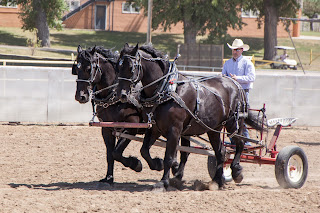One reason we came to Sheridan was to have a base camp from which to explore the area, including the Battle of the Little Bighorn National Monument. Last year we renewed our interest in the life of General George Armstrong Custer when we camped at Custer’s Gulch RV Park. The park is located on the site of Custer’s “permanent camp” where he stayed for several days in 1874 while exploring the Black Hills. (See my post from September of last year if you want to know more.)
The site of “Custer’s Last Stand” is only an hour’s drive north of Sheridan. Located beside the Little Bighorn River in the rolling plains of southern Montana, this is where, on June 25 and 25, 1876, the U.S. Army attempted to force some 6,000 to 7,000 members of several Sioux and Cheyenne tribes to return to their reservations.
Custer and the 7th Cavalry were assigned to accompany Brigadier General Alfred Terry and his Dakota Column. In accordance with Gen. Terry's strategy and orders, Custer’s command, consisting of some 600 men, attacked the Sioux and Cheyenne village. The warriors were first reported to be some 800 strong, but were later estimated to number around 2,000. Custer had divided his troops into four groups. He and 225 men died near Last Stand Hill. The other three groups lost significant numbers as well.
The Indian forces, under the command of the Oglala War Chief Crazy Horse, outsmarted, outfought and killed Custer and some 262 men. Although the Indians won the day, it was the last significant battle in the Plains Indians’ struggle to hold on to their traditional nomadic life. After the battle, most of the individual bands fled the area and ultimately returned to their reservations.
Custer and the 7th Cavalry were assigned to accompany Brigadier General Alfred Terry and his Dakota Column. In accordance with Gen. Terry's strategy and orders, Custer’s command, consisting of some 600 men, attacked the Sioux and Cheyenne village. The warriors were first reported to be some 800 strong, but were later estimated to number around 2,000. Custer had divided his troops into four groups. He and 225 men died near Last Stand Hill. The other three groups lost significant numbers as well.
The Indian forces, under the command of the Oglala War Chief Crazy Horse, outsmarted, outfought and killed Custer and some 262 men. Although the Indians won the day, it was the last significant battle in the Plains Indians’ struggle to hold on to their traditional nomadic life. After the battle, most of the individual bands fled the area and ultimately returned to their reservations.
We took a day trip to learn more about the battle and try to understand how a capable leader and decorated Civil War veteran like Custer could have made such an historic blunder. Many of the details of the story were lost with Custer and the 225 men who died alongside him, but park personnel did a fine job of explaining what historians think may have happened. If you have a chance to visit the area, be sure to watch the short film and attend one of the ranger talks detailing what is known about the battle.
As we began our tour of the battlefield and adjacent cemetery, the river valley and hills to the west were shrouded in smoke from forest fires in eastern Washington and western Montana. Based on some of the descriptions of the battle, it may have looked somewhat the same in June of 1876, although the dust and smoke from gunfire would have been much thicker.
The road through the Monument begins at Last Stand Hill, where a large obelisk lists the names of the men who fell. At the top of the column is the name of Bvt. Maj. Gen'l G.A. Custer, followed by the names of the Captains, Lieutenants and Soldiers who fell. The inscription on the base reads, "In Memory of Officers and Soldiers Who Fell Near This Place Fighting With The 7th United States Cavalry Against Sioux Indians On The 25th and 26th Of June, A.D. 1876."
Approximately 220 of the soldiers and civilians are buried at the base of the monument. Some of the officers’ remains were disinterred the following year and reburied elsewhere at the request of their families. General Custer was buried at West Point.
Approximately 220 of the soldiers and civilians are buried at the base of the monument. Some of the officers’ remains were disinterred the following year and reburied elsewhere at the request of their families. General Custer was buried at West Point.
Below the monument are white markers positioned where the members of Custer’s company fell. The place where Custer’s body was found is easy to see because his marker has a dark face.
On the opposite side of the monument is a white marble marker honoring the horses of the 7th Cavalry who died alongside their riders, sometimes killed intentionally to form a shield for the soldiers.
As we drove through the battlefield, some of which is located on private lands, we came across groups of horses grazing beside the road. It isn't hard to imagine that they might have been the decendents of mounts that survived the battle.
Actually, Comanche, the horse ridden by Captain Myles Keogh, is recognized as the only survivor of General Custer's detachment of the 7th Cavalry at the battle. Though other horses survived and were captured by the Indians, Comanche was severely wounded. Two days after the battle he was found, transported to Fort Lincoln and nursed back to health. He died at age 29, and is one of only two horses in U.S. history to be given a military funeral with full military honors.
These markers, located not far from where Custer's detachment fell, are markers for Captain Keogh's detachment where they were attacked by Crazy Horse and his forces.
The high bluffs above the Little Bighorn is the area where Custer's second in command, Major Marcus A. Reno, and his men retreated after their initial charge against the village. In the photo below, you can still see the trenches dug by the men to establish defensive positions against the Indians.
Also scattered through the park are red granite stones marking the locations where bodies of Sioux and Cheyenne warriors were found.
The high bluffs above the Little Bighorn is the area where Custer's second in command, Major Marcus A. Reno, and his men retreated after their initial charge against the village. In the photo below, you can still see the trenches dug by the men to establish defensive positions against the Indians.
Also scattered through the park are red granite stones marking the locations where bodies of Sioux and Cheyenne warriors were found.
The bodies of the Custer’s forces were hastily buried several days later when reinforcements arrived. Bodies of the warriors were taken away by their comrades and families and placed in their traditional burial grounds. For that reason, the exact number of Indian casualties is not known. It is thought to be 36-136 killed and 160 wounded.
In tribute to the Native Americans who lost their lives in the battle, the Indian Memorial was dedicated in 2003 and completed in 2013. It stands 75 yards northeast of the 7th Cavalry monument.
A "spirit gate" window allows visitors inside to see the 7th Cavalry obelisk. We were told that "Symbolically, the spirit gate welcomes the departed Cavalry solders into the memorial circle."
(P.S. Since the Monument is also a National Cemetery, pets are not allowed out of your vehicle. Either do a pet pit stop before you go in, or leave Fido in the RV or a boarding facility.)




















































